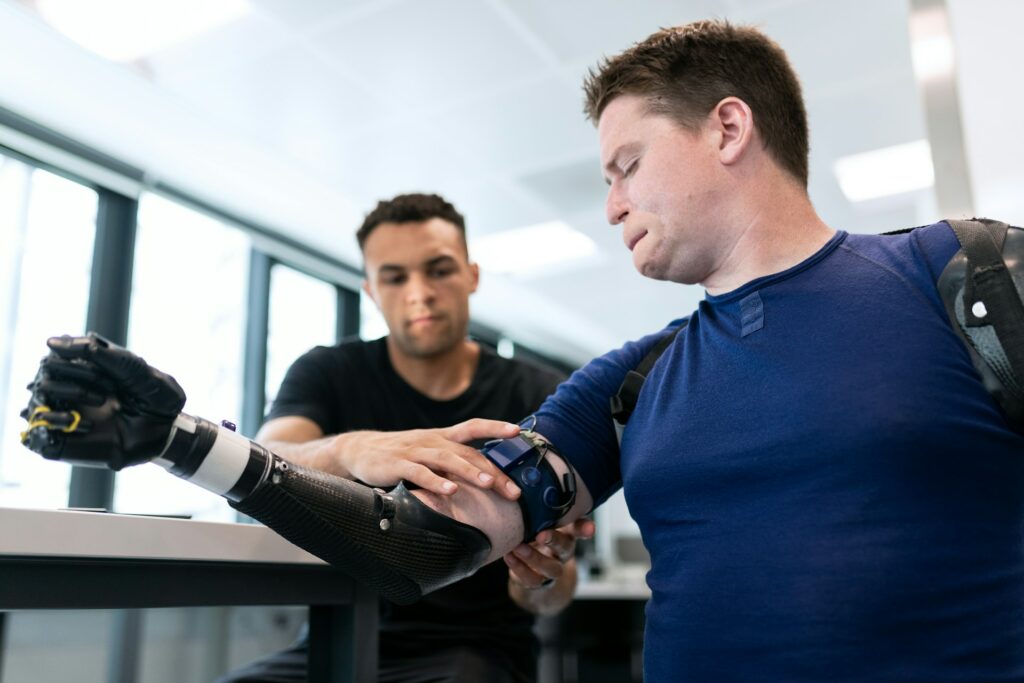A Revolutionary Approach to Prosthetics That Move Like Real Limbs

A Revolutionary Approach to Prosthetics That Move Like Real Limbs
Since the beginning of time, prosthetic limbs have been rigid, mechanical, and restricted; they were constructed with utility rather than freedom in mind. Individuals were able to walk or grip items with their assistance, but the movement they made often seemed robotic, disconnected, and far from natural. This, however, has been shifting at a breakneck pace over the course of the last several years. There is a new generation of prosthetic limbs that are developing as a result of cutting-edge advancements in robotics, neurology, and artificial intelligence. These prosthetic limbs are able to move, react, and feel nearly exactly like genuine arms and legs.
This accomplishment is not only a technological one; rather, it is one that is profoundly human. A greater sense of movement is being restored to millions of amputees all over the globe by these newly developed gadgets. Independence, dignity, and, in many instances, a sense of identity are being restored as a result of their efforts.
Changing from a Mechanical to a Neurological Perspective
Through the use of hooks or joints that were controlled by the user by changing their shoulder, elbow, or by employing levers, traditional prostheses depended on body-powered movement movements. After that came the development of electric-powered prostheses, which included motorized components and fundamental gripping capabilities. However, the true breakthrough occurred when researchers began investigating the connections between the brain and the muscles. The most cutting-edge prostheses available today are able to read electrical impulses from the remaining muscles of the user, or even directly from the neurological system. This makes it possible for the limb to move in real time, and it does so not just based on actual motion but also on the user’s desire.
The technology at question is known as myoelectric control, and it constitutes a significant paradigm change. Muscles provide electrical impulses, which are picked up by sensors that are put on the skin. After that, algorithms that are designed for machine learning decode those signals and transform them into movements that are smooth and accurate. These movements may include flexing fingers, turning a wrist, or lifting an item gently.
Limbs that are bionic and can learn and adapt
Utilizing adaptive control systems that are driven by artificial intelligence is one of the most fascinating breakthroughs. There is a possibility that these intelligent prostheses may learn how you move. Your routines and even the way your muscles contract when you are weary as opposed to when you are completely energetic are taken into consideration as they alter over time.
A number of companies, including Össur, Open Bionics, and Mobius Bionics, have developed limbs that not only imitate the motion of the human body but also enable users to fine-tune their control via the use of mobile applications. The LUKE Arm, which was named after Luke Skywalker, is one of the most sophisticated. It provides users with multi-degree control over individual fingers, wrist rotation, and elbow movement, all of which are controlled by thought-like muscle impulses. Even more interesting is the fact that researchers are working on closed-loop devices, which not only move in response to input but also convey feedback back to the brain of the user. Consequently, users are able to experience sensations such as pressure, texture, or heat via their prosthetic limbs. This is not just movement; rather, it is the resumption of feeling.
Lightweight, affordable, and printed via 3D printing
A further innovation that is shaking up the industry is the use of 3D printing. For many years, high-end prostheses were prohibitively costly and beyond of reach for a large number of individuals, particularly those living in underdeveloped nations or with low incomes. On the other hand, 3D printing is currently being used by companies and charitable organizations to manufacture limbs that are lightweight, adaptable, and economical. Several companies, such as Unlimited Tomorrow, are now in the process of developing prosthetic limbs for children that are not only affordable but also colorful, expressive, and customized to each child’s unique personality. Compared to the cumbersome, universally applicable models of the past, this is a significant improvement.
Open-source platforms are also making it possible for students, volunteers, and engineers to construct prostheses locally, making use of materials that have been repurposed and the input of the community.” It is innovation at the grassroots level that has global influence.
Limbs that are controlled by thought: the science fiction that is becoming a reality
Researchers are investigating brain-computer interfaces (BCIs) in some of the most innovative scenarios in order to provide amputees with the ability to possess direct control over prosthesis via the use of their thoughts. Instead of depending on muscle impulses, these systems implant very small electrodes in the brain or nerves. This enables the user to transmit orders to the limb just by thinking the action that they want to be performed. The clinical experiments that have been conducted at institutions like as DARPA, Johns Hopkins, and the University of Pittsburgh have shown that patients are able to manipulate robotic arms with an astounding level of accuracy. These patients have been able to hold delicate items, give handshakes, and even play video games.
In spite of the fact that these technologies are still in their infancy and need surgical implantation, they seem to be pointing toward a future in which the distinction between biological and mechanical components will be almost impossible to discern.
The Obstacles That Remain to Be Removed
In spite of the progress that has been made, challenges still exist. The cost of high-tech prostheses is often rather high, they need to be calibrated on a regular basis, and they may be challenging to maintain without assistance. Engineering difficulties that are constantly being faced include power supply, waterproofing, and wearability. A further consideration is the psychological element; it may take some time for some users to regain the ability to trust their new limbs, particularly in the case of traumatic amputation. Integration affects not just the body but also the mind and the community as well.
Moreover, access continues to be a significant problem in a lot of nations. Unless there is a worldwide drive for accessibility and financing, it is possible that the most modern prostheses may never be able to reach those who are living in locations that are plagued by poverty or conflict.
Humans and machines equal hope.
The construction of more advanced tools is not the exclusive focus of the latest generation of prosthetic innovation. The goal is to create better lives for people. People are becoming closer to completeness as a result of these sophisticated limbs, which not only restore mobility but also include the restoration of confidence, possibilities, and pleasure.
It doesn’t matter whether it’s a soldier who uses a bionic hand to learn how to cook again, a youngster who uses their 3D-printed arm to lift a toy, or a stroke patient who uses a robotic exosuit to walk again; each of these tales is a demonstration of how far we’ve gone.





